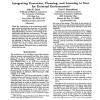Free Online Productivity Tools
i2Speak
i2Symbol
i2OCR
iTex2Img
iWeb2Print
iWeb2Shot
i2Type
iPdf2Split
iPdf2Merge
i2Bopomofo
i2Arabic
i2Style
i2Image
i2PDF
iLatex2Rtf
Sci2ools
AAAI
1990
1990
Integrating, Execution, Planning, and Learning in Soar for External Environments
Three key components of an autonomous intelligent system are planning, execution, and learning. This paper describes how the Soar architecture supports planning, execution, and learning in unpredictable and dynamic environments. The tight integration of these components provides reactive execution, hierarchical execution, interruption, on demand planning, and the conversion of deliberate planning to reaction. These capabilities are demonstrated on two robotic systems controlled by Soar, one using a Puma robot arm and an overhead camera, the second using a small mobile robot with an arm.
Related Content
| Added | 06 Nov 2010 |
| Updated | 06 Nov 2010 |
| Type | Conference |
| Year | 1990 |
| Where | AAAI |
| Authors | John E. Laird, Paul S. Rosenbloom |
Comments (0)

